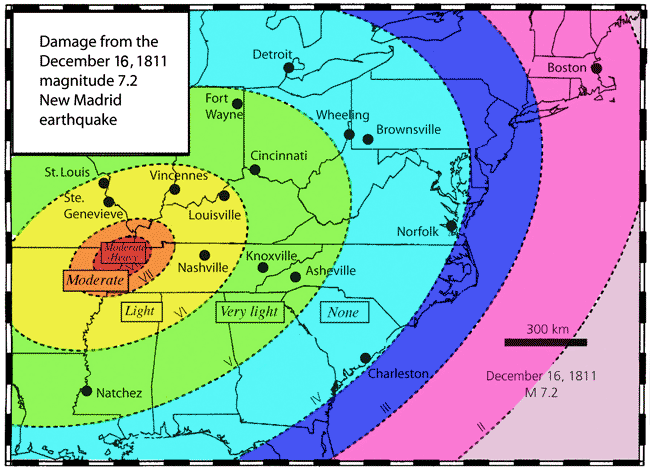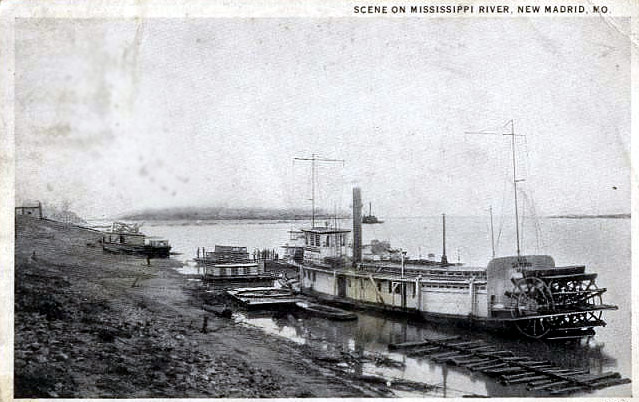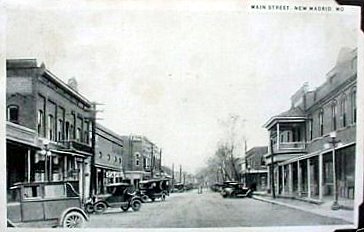Purdue University [4]
31-year old Eliza Bryan soundly slept next to her husband, an Army surgeon. Their son, Fredrick slept across the room in his warm bed. The small family resided under the same roof as Eliza’s mother in her New Madrid Territory boarding house, in what is now Missouri.[1]
It was around 2:00 a.m., the morning of December 16, 1811, when the Bryan family was jolted from their sleep by a low rumbling noise accompanied by the violent shock of an earthquake. As the Bryan family was shaken from their beds, the sounds of their neighbors screaming could be heard in the darkness. People could be heard running about panic-stricken.
Mixed in with the cries of their neighbors, Eliza could make out the panicked sounds of livestock and fowl. The sound of cracking of trees was quite evident as they were knocked over and snapped like twigs, so violent was the trembler. Even the mighty Mississippi River was halted where it flowed, only to flow in reverse, back up stream. The Bryan family was horrified as the events of the early morning played out. Their world was being shaken to its very core.
Shortly after the shaking stopped, Eliza and her neighbors noticed ‘the complete saturation of the atmosphere, with sulphurous vapor, causing total darkness.’[2] So violent was the earthquake, that noxious gasses had been shaken and released into the atmosphere. Myron Fuller wrote; "The source of the odors in the New Madrid region seems to have been the buried organic matter, which here as elsewhere in the Mississippi embayment, occurs in the alluvium and underlying Tertiary deposits, the emanations coming mainly from the carbonaceous material extruded from below through the fissures and craterlets, which were numerous in the region." [3]
As the night wore on, more aftershocks occurred. Eliza and her family most certainly would have been relieved as sunrise approached and as the aftershocks began to subside in intensity, although not all of the shocks were less in intensity. One aftershock was felt to be severe enough to actually rival if not surpass the intensity of the original earthquake. As the aftershocks happened, the people remained unsettled and frightened.
Eliza observed that “The inhabitants fled in every direction to the country, supposing (if it can be admitted that their minds can be exercised at all) that there was less danger at a distance from, than near to the river.” [2] So panicked were the people that one woman even fainted, and then died from the fright.
As time went on, there were fewer and less intense aftershocks until January 23, 1812. On that day another severe quake as intense as any of the former shakers occurred. The quakes continued through February 4. Eliza thought the earth had been in an almost continual motion and state of agitation for weeks.
On February 7, again in the early morning hours at about 4:00 a.m., another earthquake manifested itself of an intensity that was more violent than any of the earthquakes that had preceded it in weeks past. All of the events that occurred during the original quake accompanied this latest and more severe earthquake.
With this latest shock, the Mississippi River receded its banks so violently that stands of cottonwood trees were snapped by fifteen to twenty foot waves, while boats that had been passing through on their way to New Orleans were deposited on bare sand. Then the waters returned, flowing back down the river, tearing the boats from their moorings and sending them up another creek nearly a quarter mile. Fish were strewn on the banks of the river and Eliza noted that the entire Mississippi River was strewn with the wrecks of boats. One boat was destroyed, killing a woman and six children.
Mixed in with the cries of their neighbors, Eliza could make out the panicked sounds of livestock and fowl. The sound of cracking of trees was quite evident as they were knocked over and snapped like twigs, so violent was the trembler. Even the mighty Mississippi River was halted where it flowed, only to flow in reverse, back up stream. The Bryan family was horrified as the events of the early morning played out. Their world was being shaken to its very core.
Shortly after the shaking stopped, Eliza and her neighbors noticed ‘the complete saturation of the atmosphere, with sulphurous vapor, causing total darkness.’[2] So violent was the earthquake, that noxious gasses had been shaken and released into the atmosphere. Myron Fuller wrote; "The source of the odors in the New Madrid region seems to have been the buried organic matter, which here as elsewhere in the Mississippi embayment, occurs in the alluvium and underlying Tertiary deposits, the emanations coming mainly from the carbonaceous material extruded from below through the fissures and craterlets, which were numerous in the region." [3]
As the night wore on, more aftershocks occurred. Eliza and her family most certainly would have been relieved as sunrise approached and as the aftershocks began to subside in intensity, although not all of the shocks were less in intensity. One aftershock was felt to be severe enough to actually rival if not surpass the intensity of the original earthquake. As the aftershocks happened, the people remained unsettled and frightened.
Eliza observed that “The inhabitants fled in every direction to the country, supposing (if it can be admitted that their minds can be exercised at all) that there was less danger at a distance from, than near to the river.” [2] So panicked were the people that one woman even fainted, and then died from the fright.
As time went on, there were fewer and less intense aftershocks until January 23, 1812. On that day another severe quake as intense as any of the former shakers occurred. The quakes continued through February 4. Eliza thought the earth had been in an almost continual motion and state of agitation for weeks.
On February 7, again in the early morning hours at about 4:00 a.m., another earthquake manifested itself of an intensity that was more violent than any of the earthquakes that had preceded it in weeks past. All of the events that occurred during the original quake accompanied this latest and more severe earthquake.
With this latest shock, the Mississippi River receded its banks so violently that stands of cottonwood trees were snapped by fifteen to twenty foot waves, while boats that had been passing through on their way to New Orleans were deposited on bare sand. Then the waters returned, flowing back down the river, tearing the boats from their moorings and sending them up another creek nearly a quarter mile. Fish were strewn on the banks of the river and Eliza noted that the entire Mississippi River was strewn with the wrecks of boats. One boat was destroyed, killing a woman and six children.
Scene On Mississippi River, New Madrid, Mo.
Soon, the quakes began to quiet down and people began to rebuild their lives. Some had permanently moved away, fearing more quakes. Others stubbornly dug in and began to reclaim their lives. Eliza Bryan observed as an eyewitness some of the after effects of the earthquakes, which she describes; “The site of this town was evidently settled down at least fifteen feet, and not more than a half a mile below the town there does not appear to be any alteration on the bank of the river, but back from the river a small distance, the numerous large ponds or lakes, as they are called, which covered a great part of the country were nearly dried up. The beds of some of them are elevated above their former banks several feet, producing an alteration of ten, fifteen to twenty feet, from their original state. And lately it has been discovered that a lake was formed on the opposite side of the Mississippi, in the Indian country, upwards of one hundred miles in length, and from one to six miles in width, of the depth of ten to fifty feet. It has communication with the river at both ends, and it is conjectured that it will not be many years before the principal part, if not the whole of the Mississippi, will pass that way.” [2] Eliza also described that in other parts of the country and surrounding area, numerous lakes and ponds were elevated above their banks with many drying up.
Meanwhile, for about 18 months after the event, Eliza, her family, and other families moved from their homes into makeshift shacks for fear that their homes would collapse. Eventually, as the earthquake activity subsided, many moved back into their homes, and the years went on as generations passed. The New Madrid Earthquake became but a distant memory and soon would become an almost forgotten and minor footnote of the past.
Downtown New Madrid in 1920s [5]
Epilogue
Wikipedia reports the following about the New Madrid Seismic Zone and the potential for a future earthquake; "The New Madrid seismic zone had four of the largest North American earthquakes in recorded history, with moment magnitudes estimated to be as large as 8.0, all occurring within a three-month period between December 1811 and February 1812.
In a report filed in November 2008, The U.S. Federal Emergency Management Agency warned that a serious earthquake in the New Madrid Seismic Zone could result in "the highest economic losses due to a natural disaster in the United States," further predicting "widespread and catastrophic" damage across Alabama, Arkansas, Illinois, Indiana, Kentucky, Mississippi, Missouri and particularly Tennessee, where a 7.7 magnitude quake or greater would cause damage to tens of thousands of structures affecting water distribution, transportation systems, and other vital infrastructure.
The potential for the recurrence of large earthquakes and their impact today on densely populated cities in and around the seismic zone has generated much research devoted to understanding in the New Madrid Seismic Zone. By studying evidence of past quakes and closely monitoring ground motion and current earthquake activity, scientists attempt to understand their causes and recurrence intervals."[7]
Sources Cited
[1] Center For Earthquake Research and Information
[2] The Virtual Times - The New Madrid Earthquake
[3] Myron Fuller - The New Madrid Earthquake (A Scientific Factual Field Account) (1912) pp.45-46
[4] Purdue University Map
[5] Scene On Mississippi River, New Madrid, Mo.
[6] Downtown New Madrid in 1920s
[7] Wikipedia - New Madrid Seismic Zone


